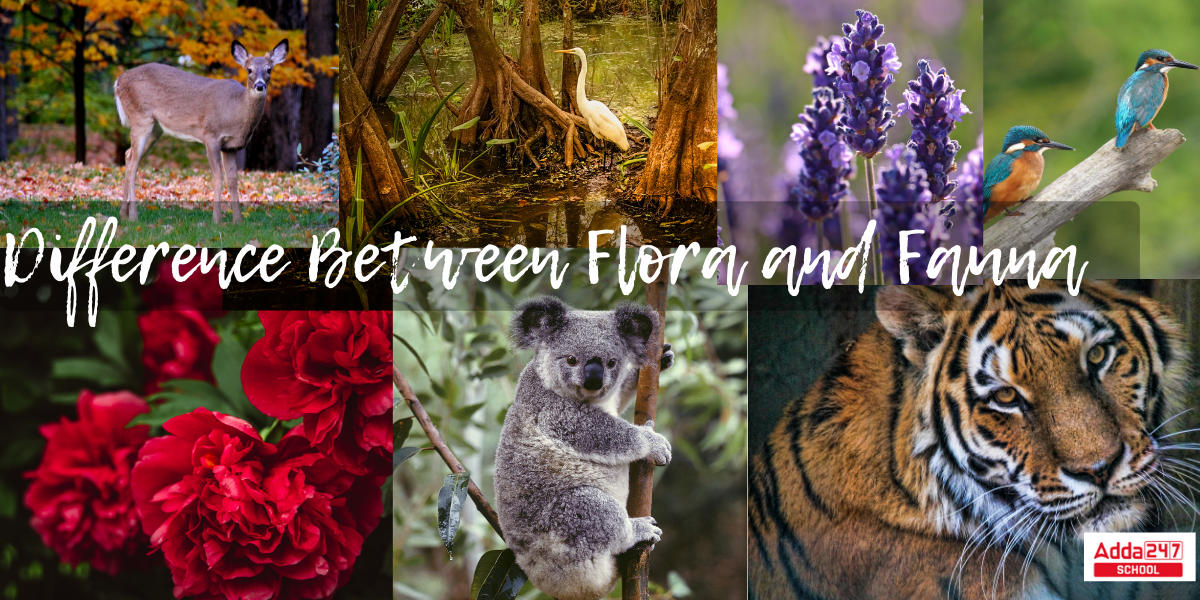Table of Contents
Difference Between Flora and Fauna
The difference Between Flora and Fauna is simply explained here. Flora and fauna represent the plants and animals in simple terms that embrace every living organism on the Planet. Biotic components include all living organisms, including animals, plants, and bacteria. Contrarily, abiotic components are non-living elements like soil, water, and climate that are essential for the survival of life. There are 8.7 million kinds of flora and fauna on the planet. Flora and fauna are essential for human existence because they regulate the levels of oxygen and carbon dioxide in the atmosphere. India ranks #10 in terms of flora and fauna diversity. In this post, we will learn what flora and fauna are, the Difference Between Flora and Fauna, and how they contribute to the earth.
Differentiate between flora and fauna
The flora, fauna, microbes, and other forms of life found in any region are referred to as biota. Flora refers to the plants that grow in a specific geographical area during a specific time period, whereas fauna relates to the group of creatures that exist in a specific geographical area over a specific time period. Forests comprise almost 30% of the Earth’s land surface and are home to 80% of the world’s terrestrial creatures.
Difference Between Flora and Fauna
What is Flora?
Flora comes from the Latin language. It refers to a grouping of native plants within an environment. They can be classified based on climate, area, time period, and other factors. However, we generally categorize it based on the environment in which it occurs natively.
- Native flora, agricultural flora, horticultural flora, and weed flora are all types of plants. Normal Flora and Transient Flora are the two forms of flora.
- They are a vital component of the ecosystem. Photosynthesis in plants converts carbon dioxide and sunlight into oxygen and glucose, which is critical for the existence of practically all living things.
- They also give us a variety of food, beverages, and medicines.
- Among the flora are desert plants, water plants, and plants that grow in hilly places.
- Cactus is a desert plant that possesses adaptations such as adapted leaves and prickles for the preservation of water and safeguarding against predators.
What is Fauna?
There are numerous theories as to how the word came to be. According to one source, “fauna” means “forest spirit.” The fauna depicts the life of a native animal in the area.
- As a result, fauna classification is far more complicated than flora classification. Animals, birds, and germs are all included.
- Fauna is unable to produce their own food and must rely on plants and animals.
- As a result, for ease of categorization, birds are classified as Avifauna. Pisci fauna includes fish. The microbiota consists of microorganisms such as bacteria and viruses that are typically attributed to the animal kingdom. Cryptofaunas are all undiscovered and unknown animals.
Difference Between Flora and Fauna in Tabular Form
There are significant difference between flora and Fauna. Flora is thought to include any organisms that can synthesize their sustenance and are nearly stationary. It encompasses all plants, shrubs, trees, and so on. Fauna is living beings that require nourishment from other sources and are categorized as movable organisms. So to understand the contrast better read the following Difference Between Flora and Fauna in tabular Form.
| Difference Between Flora and Fauna | ||
| Pointers | Flora | Fauna |
| Definition | The terminology refers to the natural vegetation in a certain geographical location, which includes plants, fungi, algae, and other organisms. | This refers to animals that reside in a certain geographical region, such as mammals, birds, microbes, and others. |
| Participants | This category includes all live plants. | This category includes all live animals. |
| What is the Study of Flora, Fauna called? | Botany is the study of plants, and a botanist is someone who studies it. | Zoology is the study of fauna, and a Zoologist is someone who studies it. |
| Classification | Native flora, agricultural flora, horticultural flora, and weed flora are all examples of flora. | Cryofauna, cryptofauna, infauna, epifauna, macrofauna, megafauna, meiofauna, and microfauna are all types of animals. |
| Nutrition | Autotrophs are organisms that can generate their food and energy. | Heterotrophs that rely on plants for food and energy |
| Climate | Climate affects flora. | Fauna affects the climate. |
| Evolution | Flora is the first form of life to come to earth | fauna appeared after flora |
| Locomotion | Immovable | Mobile, all animals can move from one place to another. |
| Chloroplast | Present | Not present |
| Cell Wall | They have a cell wall in them. | Fauna doesn’t have cell walls |
| Example | Forests, flowering plants, grasslands, trees, etc. | Animals, birds, fish, humans, insects, etc. |
Importance of Flora and Fauna
The natural world is a complicated, interwoven network of biotic and abiotic factors. Furthermore, biotic elements include all living species such as plants, animals, and microbes, or Flora and Fauna. The flora and fauna of a specific ecosystem perform critical roles in the environment and give countless benefits. The importance of Flora and Fauna is discussed below.
Keeps the environment in balance
Animals and plants are critical to human survival. The flora produces oxygen, which the fauna utilizes for respiration. After that, the fauna emits carbon dioxide. Photosynthesis is carried out by the flora using carbon dioxide. Animals and plants provide significant benefits to humanity by healing and providing sustenance. Animals keep the planet in balance by hunting a wide range of plants and animals. Fertiliser can be obtained from animal excrement. Animals that die decay and serve as auxiliary minerals for other living creatures.
Different species coexisting
As in the instance of pandas and bamboo plants, the existence of one species is dependent on the presence of the other. The Panda’s sole source of sustenance is bamboo stalks. The clearance of forests of bamboo in China has harmed the panda, resulting in starvation and habitat loss.
Local Economic Expansion
Through tourism, animals and plants benefit the local economy. The Amazon forest’s flora and fauna attract tourists and scientists, contributing over fifty million dollars to the Brazilian economy.
Aesthetic Appeal of Flora and Fauna
The flora and fauna that abound on the planet contribute to its aesthetic value. People enjoy the splendor of the scenery by visiting various biosphere reserves, national parks and zoos, woodlands, and botanical gardens. This clarifies the significance of flora and fauna in our everyday lives.
Distinguish between Flora and Fauna
Flora and fauna are two terms used to categorize the different components of the natural world, specifically in relation to living organisms. Here’s how they are distinguished:
- Flora:
- Flora refers to the collective plant life or plant species found in a particular region, ecosystem, or environment.
- It includes all types of plants, from trees, shrubs, and grasses to flowers, mosses, ferns, and algae.
- Flora encompasses both native and introduced plant species in a given area.
- Botanists and ecologists often study flora to understand plant distribution, diversity, and ecological relationships.
- Fauna:
- Fauna, on the other hand, refers to the collective animal life or animal species found in a specific region, ecosystem, or habitat.
- It includes all types of animals, such as mammals, birds, reptiles, amphibians, fish, insects, and other invertebrates.
- Fauna encompasses both terrestrial and aquatic animals, including both vertebrates and invertebrates.
- Zoologists and ecologists study fauna to explore animal behavior, populations, and interactions with their environment.
In summary, flora pertains to plants, while fauna pertains to animals. Together, these terms encompass the entire spectrum of living organisms in a given area, making them essential concepts in ecology and biology for understanding and studying the natural world.



 NEET City Intimation Slip 2025 Out at ne...
NEET City Intimation Slip 2025 Out at ne...
 {LIVE Update} MP Board Result 2025 Date,...
{LIVE Update} MP Board Result 2025 Date,...
 UP Board Class 12 Grading System 2025, H...
UP Board Class 12 Grading System 2025, H...










